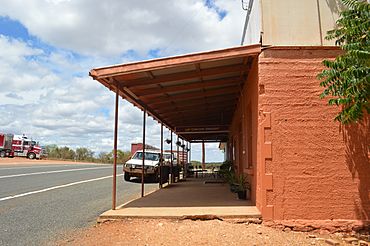Mount Hope, New South Wales facts for kids
Quick facts for kids Mount HopeNew South Wales |
|
|---|---|

The Royal Hotel at Mount Hope.
|
|
| Population | 19 (2016) |
| Elevation | 223 m (732 ft) |
| Location | 94.7 km (59 mi) NNE of Hillston |
| LGA(s) | Cobar Shire |
| Federal Division(s) | Parkes |
Mount Hope (elevation 223 m) is a settlement in western New South Wales, Australia. It is situated on the Kidman Way, 95 kilometres north of Hillston and 160 km south of Cobar. During the 1870s, a copper mine commenced operations at Mount Hope. In the mid-1880s, a proposed township in the area was officially surveyed and named Nombinnie, but the name has seldom been used. In the meantime, the town of Mount Hope sprang up, closer to the mine.
At the 2016 census, Mount Hope and surrounding area had a population of 19 people living in 9 private dwellings, with a median age of 31 years. The only remaining business at Mount Hope is the Royal Hotel (commonly referred to as the 'Mount Hope Pub') which offers food, beverages and accommodation (though fuel is no longer available).
History
The town was once a busy copper mining town in the 1890-1920s. At the 2006 census, Mount Hope had a population of 53 people. Much of the township was destroyed in a major bushfire in the 1950s. Travellers are warned that there is no fuel available in this village. It has its own crossover air strips still being used today. The only visible business open in the village is the Royal Hotel, commonly known as the "Mount Hope Pub".
The Royal Hotel
The Royal Hotel is a survivor from the heyday of Mount Hope. The Royal Hotel was one of four hotels granted licenses during 1881 as the New Mount Hope Copper Mining Company built infrastructure, installed machinery and commenced mining and smelting operations at Mount Hope. The first of the licensed premises was the Mount Hope Hotel in March 1881, followed by William Clark’s Royal Hotel (July), Thomas Saunders’ Albion Hotel (August) and John Lees’ Commercial Hotel (November 1881). In September 1882 a license was granted to James Lyell for the Great Central Hotel at South Mount Hope. William and Sarah Clark and family had been living in the Mount Hope district since about 1876. Clark was also an owner of a store at Mount Hope township.
During the period 1898 to 1905 Louis Mozzini, previously from Hillston, became the licensee of the Royal Hotel. William Clark resumed as licensee of the hotel from July 1905.
William Clark died in February 1910 at Waverley in Sydney. His widow Sarah Clark took over the license of the Royal Hotel at Mount Hope after his death. In July 1912 the license was transferred from Sarah Clark to her son, William Frederick Clark. The correspondent made the comment: “We wish the new proprietor luck in his undertaking and hope that business in Mount Hope will soon liven up so as to compensate all business people for their endurance”. In about 1917 the Clark family sold the Royal Hotel to B. A. Davis.
In 1930 the Royal Hotel was owned by John Swasbrick (Snr.) and the licensee was Mrs. W. Davis. In December 1930 a fire destroyed the Royal Hotel. At the subsequent inquiry by the Coroner it was pointed out that “although the building was constructed chiefly of concrete and iron with an absolute minimum of wood, the building was on fire throughout its length and breadth in an incredibly short space of time, the fire spreading rapidly even against the wind”. The inquiry revealed that “the owner was not in embarrassed circumstances, although the licensee was” and returned an open verdict regarding the origin of the fire.
In June 1933 John Swasbrick died at his residence, the Royal Hotel, aged 79 years. At the time of his death Swasbrick was the owner and licensee of the hotel.
The Royal Hotel at Mount Hope offers cold drinks and hot beverages. It serves counter meals and snacks and has accommodation facilities, but fuel is no longer available at the hotel. The Royal claims to have the only concrete bar in New South Wales.
Environment
Mount Hope is surrounded by three extensive nature reserves: Yathong, Nombinnie and Round Hill. The reserves comprise a large area of plain and ridge country on the boundaries between three major biophysical regions: the Cobar Peneplain, the Darling Depression and the Southern Riverine Plain. The area protects the largest remaining contiguous stand of mallee in NSW and supports a rich diversity of flora and fauna, including many rare and endangered species.
Round Hill Nature Reserve (south-east of Mount Hope), Nombinnie Nature Reserve (to the south) and Yathong Nature Reserve (to the north-west) are included in the 2,500 square kilometres Central NSW Mallee Important Bird Area because of its significance for bird conservation, especially of the malleefowl and red-lored whistler.


